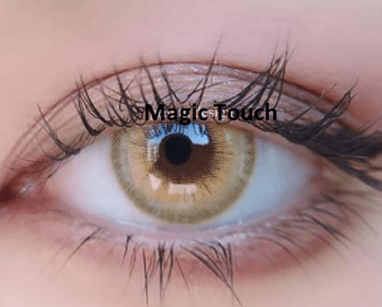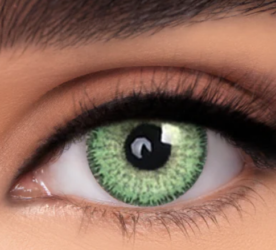
Changing eye color is not a simple or safe process. It is an absolutely amazing procedure that works now in 2023 but many conditions need to be met.
The color of your eyes is determined by the amount and type of pigments in your iris, and this is largely determined by your genetics.
As it is important to understand how works things, check out our different keratopigmentation posts.
While there are some contact lenses that can temporarily change the appearance of your eye color, there are no safe and effective methods for permanently changing your eye color. Here are some things to consider:
Colored Contact Lenses: Colored contact lenses are a popular way to temporarily change your eye color. These lenses are available with or without a prescription and come in a variety of colors and designs. They can provide a different look, but they are not permanent, and you must follow proper hygiene and care instructions when using them to avoid eye problems.
Surgical Procedures: Some surgical procedures claim to permanently change eye color, but these are highly controversial and not widely accepted in the medical community. These procedures typically involve implanting a colored artificial iris in the eye. They come with serious risks and complications, including vision loss, glaucoma, and cataracts. They are generally not recommended and may be illegal in some places.

Cosmetic Iris Implants: Cosmetic iris implants are a type of surgical procedure where a silicone implant is placed over the natural iris to change its color. Like other surgical procedures, this method carries significant risks, including vision impairment and other complications. It’s essential to consult with a qualified ophthalmologist before considering any surgical procedure.
Cosmetic Iris Laser Treatment: Some clinics claim to offer laser treatments to change eye color by destroying the melanin in the iris. However, these procedures are not well-researched, and their long-term safety and effectiveness are unknown. They can also carry risks to your vision and eye health.
Natural Methods: There are no safe and proven natural methods to change eye color. Some people believe that certain foods, supplements, or eye exercises can influence eye color, but there is no scientific evidence to support these claims.
All these methods are the traditional ones and answers you got since many years now. Yes but that was before 2022-2023 when Keratopigmentation procedure surged.
Keratopigmentation changed the eye color procedure landscape. Thanks to refractive technology it is fair to say it works…but under some conditions.
What is Keratopigmentation procedure?
Keratopigmentation is primarily used in two main contexts:
Keratopigmentation is a cosmetic procedure that involves the tattooing of the cornea, which is the clear front surface of the eye. It is typically used to alter the appearance of the cornea for medical or cosmetic reasons. This procedure is also sometimes referred to as corneal tattooing or corneal micropigmentation.
Medical Reasons: It can be used to improve the appearance of the eye in cases where the cornea has sustained damage, such as scarring or discoloration due to injury, surgery, or diseases like corneal dystrophy. In such cases, keratopigmentation can help to mask or reduce the visibility of corneal irregularities, improving the cosmetic appearance of the eye and potentially restoring the patient’s self-esteem.
Cosmetic Enhancement: Some individuals may opt for keratopigmentation for purely cosmetic reasons, seeking to change the color or appearance of their corneas. This is an elective procedure and is not typically recommended unless there is a strong desire for cosmetic enhancement.

The procedure involves the use of specialized pigments and a skilled practitioner who carefully applies tiny dots or lines of pigment to the corneal surface to achieve the desired color or effect. It is essential to note that this procedure carries risks and is not without potential complications. Risks can include infection, inflammation, and vision problems.
Keratopigmentation should only be performed by highly trained and experienced medical professionals, such as ophthalmologists, who specialize in corneal procedures. It is crucial to have a thorough discussion with a qualified eye specialist before considering keratopigmentation to understand the potential benefits, risks, and whether it is the right choice for your specific situation.
When refering to Keratopigmentation or pigmentation of eyes we refer to a new cosmetic procedure provided not by plastic surgeons but by ophthalmologists.

It uses refractive technology that is used since 20 years now since the beginning of years 2000 to bring something really new.
While some individuals may have personal preferences or reasons for wanting to change their eye color, it’s important to note that there are no significant health or functional benefits to changing one’s eye color. Here are some potential benefits people may associate with changing eye color and it is purely the decision of each one of us:
Enhanced Aesthetic Appearance: Some individuals may wish to alter their eye color to achieve a different look or to enhance their overall appearance. Changing eye color can be seen as a form of self-expression and personal style.
Temporary Transformation: Colored contact lenses offer a temporary way to change eye color. This allows individuals to experiment with different eye colors without making a permanent commitment.
Confidence and Self-Esteem: For people with certain eye conditions or irregularities that affect the appearance of their eyes, changing eye color through medical procedures may boost their confidence and self-esteem by improving the aesthetics of their eyes.
Camouflaging Eye Imperfections: In some medical cases, such as corneal scarring or discoloration, keratopigmentation (corneal tattooing) may be used to mask or reduce the visibility of eye imperfections, potentially improving the eye’s appearance.

- The protocol for keratopigmentation involves several steps, and it is essential that the procedure is performed by a skilled and experienced practitioner. Here is a general outline of the keratopigmentation procedure protocol:
- Patient Consultation and Evaluation:
- The process typically begins with a thorough consultation with the patient to discuss their goals, expectations, and any potential medical or cosmetic reasons for undergoing keratopigmentation.
- The ophthalmologist will assess the patient’s eye health, the condition of the cornea, and the suitability of the procedure for the individual.
- Informed Consent:
- The patient will be provided with detailed information about the procedure, its potential risks, benefits, and alternatives. Usually you receive a quote before coming to the eye clinic.
- Informed consent must be obtained from the patient, indicating their understanding and agreement to proceed with keratopigmentation.
- Color Selection:
- The patient and practitioner will discuss and select the desired eye color or shade for the procedure.
- The practitioner may use specialized color-matching techniques to determine the appropriate pigment.
- Preparation and Anesthesia:
- The patient’s eye will be thoroughly cleaned, and topical anesthesia (numbing eye drops) will be applied to ensure comfort during the procedure.
- The patient will be asked to keep their eye still and open during the procedure.
- Pigment Application:
- Using a specialized instrument, such as a micro-needle or tattooing device, the practitioner will carefully deposit pigments onto the cornea’s surface in the desired pattern or shape.
- The pigments are applied in a controlled and precise manner, often as tiny dots or lines, to achieve the desired color and appearance. What matters is how the tunnel is created and what types of pigments are inserted, are they certified pigments?
- Post-Procedure Care:
- After the procedure, the patient may be given instructions on eye care, including the use of antibiotic or anti-inflammatory eye drops to prevent infection and reduce inflammation.
- The patient may be advised to avoid certain activities and environments that could increase the risk of complications during the healing process.
- Follow-Up Appointments:
- Patients typically require several follow-up appointments to monitor the healing process and assess the results.
- Additional touch-up procedures may be necessary to achieve the desired appearance.
